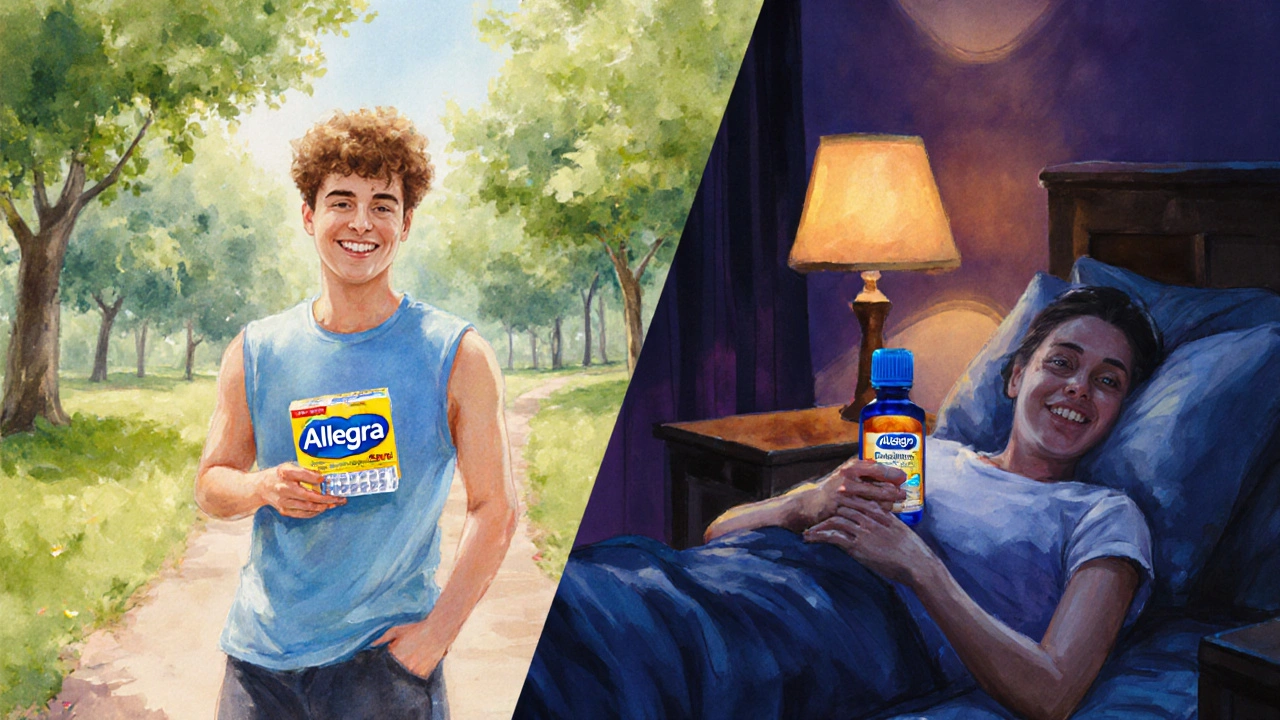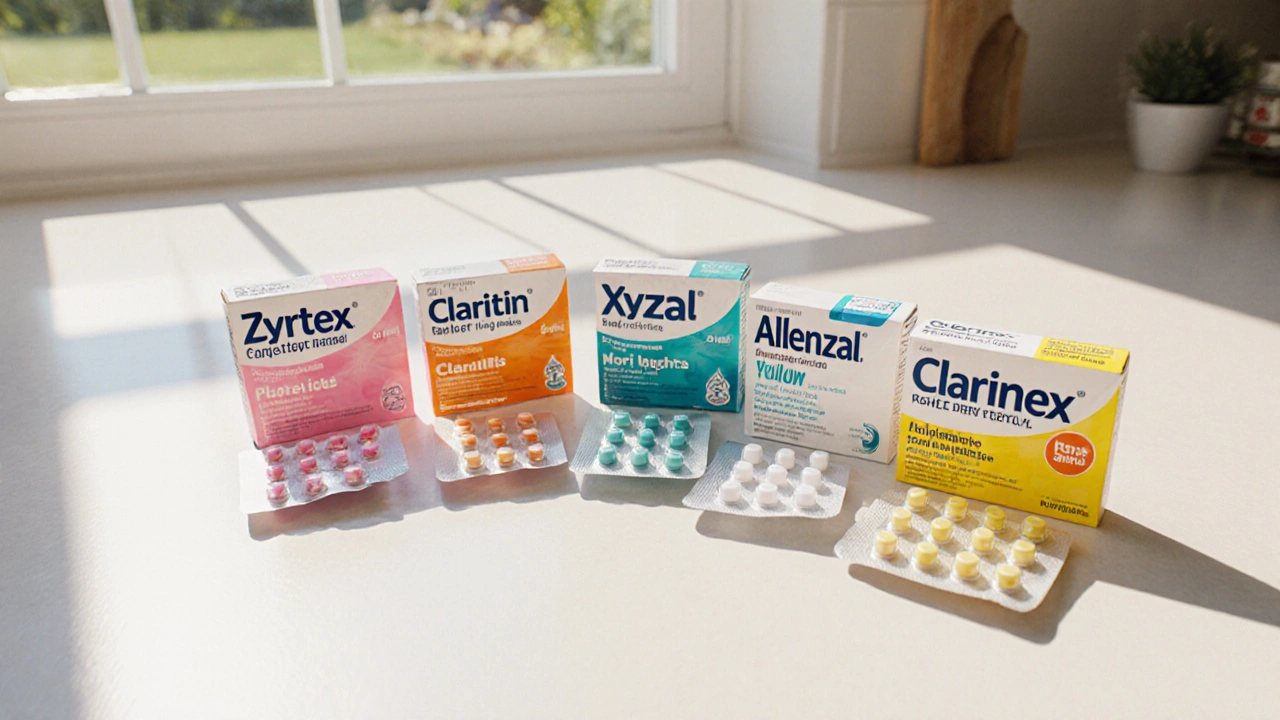Antihistamine Selector Tool
Choose the priorities that matter most to you and see which antihistamine is the best match for your allergy needs.
How important is fast relief?
How important is avoiding drowsiness?
What's your budget priority?
Do you need pregnancy safety?
Your Recommendation
Select your priorities and click "Find My Best Antihistamine" to see your personalized recommendation.
Key Takeaways
- If you want a non‑sedating daily allergy pill, Zyrtec, Claritin, Allegra, Xyzal or Clarinex are solid choices.
- Benadryl works fast but can make you drowsy, so save it for occasional flare‑ups or nighttime use.
- Price differences are small; insurance coverage often decides the cheapest option.
- Pregnancy safety is similar across most second‑generation antihistamines (Category B).
- Look at onset, duration, and drowsiness risk to match the drug with your lifestyle.
If you’re doing a Zyrtec compare to decide which antihistamine fits your life, you’re in the right place.
How Antihistamines Work
Allergy symptoms-sneezing, itching, watery eyes-are triggered when histamine binds to H1 receptors in the nose, eyes, and skin. Antihistamines block those receptors, stopping the cascade that leads to inflammation. First‑generation drugs like diphenhydramine cross the blood‑brain barrier, causing sedation. Second‑generation agents were designed to stay out of the brain, delivering relief without making you feel sleepy.
Zyrtec (Cetirizine) - The Basics
When you reach for an allergy pill, Zyrtec is the brand name for cetirizine, a second‑generation antihistamine that blocks histamine receptors with minimal drowsiness for most users. It was approved by the FDA in 1995 and became OTC in 2007. The standard adult dose is 10mg once daily, and it works for up to 24hours. Clinical trials show about 60% of users experience noticeable relief within an hour.
Common Alternatives
Claritin (Loratadine)
Claritin is the brand name for loratadine, a second‑generation antihistamine known for its low sedation profile. It was introduced in 1993, OTC since 2002, and is taken as 10mg once daily. Onset is slightly slower than Zyrtec, typically 2hours, but it maintains 24‑hour relief.
Allegra (Fexofenadine)
Allegra is the brand name for fexofenadine, another second‑generation antihistamine that essentially eliminates drowsiness. Commonly dosed at 180mg once daily, it starts working in about an hour and lasts a full day. Its chemical structure prevents it from entering the brain, making it a favorite for people who need to stay alert.
Benadryl (Diphenhydramine)
Benadryl is the brand name for diphenhydramine, a first‑generation antihistamine that causes significant sedation. It’s usually taken 25‑50mg every 4-6hours for acute symptoms. Onset is rapid-within 15‑30minutes-but the relief window is short (4‑6hours) and drowsiness is common.
Xyzal (Levocetirizine)
Xyzal is the brand name for levocetirizine, the active enantiomer of cetirizine, offering similar efficacy with slightly lower drowsiness rates. The typical adult dose is 5mg once daily. Clinical data suggest onset within 60minutes and a 24‑hour duration, comparable to Zyrtec.
Clarinex (Desloratadine)
Clarinex is the brand name for desloratadine, a third‑generation antihistamine derived from loratadine. It’s taken as 5mg once daily and provides non‑sedating relief for up to 24hours. Onset is about an hour, and it’s also OTC in many countries.
Side‑by‑Side Comparison
| Antihistamine | Onset (min) | Duration (hr) | Drowsiness Risk | Pregnancy Category | OTC? | Typical Adult Dose | Approx. US$ (30 tablets) |
|---|---|---|---|---|---|---|---|
| Zyrtec (Cetirizine) | 60 | 24 | Low (≈5%) | B | Yes | 10mgoncedaily | 12 |
| Claritin (Loratadine) | 120 | 24 | Low (≈2%) | B | Yes | 10mgoncedaily | 10 |
| Allegra (Fexofenadine) | 60 | 24 | Very Low (≈1%) | B | Yes | 180mgoncedaily | 13 |
| Benadryl (Diphenhydramine) | 30 | 4‑6 | High (≈50%) | B | Yes | 25‑50mgq4‑6h | 8 |
| Xyzal (Levocetirizine) | 60 | 24 | Low (≈2%) | B | Yes | 5mgoncedaily | 14 |
| Clarinex (Desloratadine) | 60 | 24 | Low (≈1%) | B | Yes | 5mgoncedaily | 15 |

How to Choose the Right Antihistamine
Think of the decision as matching three variables: speed, stay‑awake needs, and budget. Use the quick guide below.
- Fast relief for sudden flare‑ups: Benadryl’s 30‑minute onset is unbeatable, but be ready for drowsiness. Pair it with a non‑sedating daily pill for baseline control.
- All‑day, no‑sleepiness: Zyrtec, Claritin, Allegra, Xyzal, and Clarinex all provide 24‑hour coverage. If you’re ultra‑sensitive to any sedation, Allegra or Clarinex are the safest bets.
- Kids & pregnancy: All second‑generation options share Category B safety, but the lowest pediatric dosing is Zyrtec (5mg for ages 2‑5). Always check with a pediatrician.
- Cost‑conscious shoppers: Generic cetirizine and loratadine are typically the cheapest (<$10 for a month’s supply). Brand‑name Xyzal and Clarinex hover around $15, so insurance or discount cards matter.
- Specific triggers: Some users report that fexofenadine works better for outdoor pollen, while cetirizine handles indoor dust mites more reliably. Track your own symptom diary.
Potential Side Effects & Interactions
Second‑generation antihistamines are generally well‑tolerated. Common complaints include mild headache, dry mouth, or occasional fatigue. Rarely, people experience a paradoxical increase in itching.
Drug interactions to watch for:
- Alcohol amplifies drowsiness, especially with diphenhydramine.
- Antacids or fruit juices can reduce fexofenadine absorption.
- Ketoconazole and erythromycin may raise cetirizine levels.
- Monoamine‑oxidase inhibitors (MAOIs) can heighten side‑effects of any antihistamine.
Always consult a pharmacist if you’re on chronic medications like blood thinners or antidepressants.
Frequently Asked Questions
Can I take Zyrtec and Claritin together?
Mixing two second‑generation antihistamines isn’t recommended because it doesn’t provide extra relief but can increase side‑effects. If one isn’t controlling symptoms, switch to the other rather than stacking.
Is Benadryl safe for children?
Yes, for kids over 2years old at a reduced dose (12.5‑25mg every 4‑6hours). However, because it makes children sleepy, many parents prefer a pediatric‑rated cetirizine formulation.
Which antihistamine works best for hay fever?
Hay fever often responds well to any second‑generation antihistamine. Users with nighttime symptoms sometimes choose Allegra for its ultra‑low sedation, while Zyrtec is popular for its strong affinity to the H1 receptor.
Can I use these pills while pregnant?
All the listed second‑generation antihistamines carry FDA Pregnancy Category B, indicating no proven risk in animal studies. Still, discuss any medication with your OB‑GYN before starting.
Do antihistamines interact with COVID‑19 vaccines?
Current data suggest that routine antihistamines do not diminish vaccine efficacy. If you’re taking a high‑dose diphenhydramine for an allergic reaction, wait a few hours after the injection to avoid confounding side‑effects.


Sayam Masood
October 12, 2025 AT 04:53When we weigh the scales of relief versus sedation, the choice feels almost metaphysical – a balance between the urgent need to breathe freely and the desire to stay present. Zyrtec sits somewhere in the middle, offering a respectable onset without dragging you into a fog. Yet, the world of antihistamines is a mosaic of trade‑offs that each of us must map onto our own daily rhythm. In the end, the right pill is the one that aligns with the cadence of your life.
Jason Montgomery
October 16, 2025 AT 07:46Totally get where you’re coming from – it’s all about matching the med to your schedule. If you need something that kicks in quick for a surprise pollen burst, Zyrtec’s 60‑minute window is solid, and you won’t feel like you’re on a coffee break. For those marathon days, swapping in an Allegra can keep you sharp without the sleepy vibe. Keep experimenting until the combo feels just right for you.
Wade Developer
October 20, 2025 AT 10:40The pharmacological profile of cetirizine suggests a high affinity for peripheral H1 receptors while maintaining limited central penetration. Consequently, its drowsiness incidence remains modest compared with first‑generation agents. Clinical data demonstrate that approximately 60 % of patients achieve perceptible relief within one hour of a single 10 mg dose. Nonetheless, individual variability in metabolism can shift both onset and duration. Practitioners should therefore weigh the patient’s occupational demands when recommending a regimen.
rama andika
October 24, 2025 AT 13:33Oh sure, because Big Pharma totally isn’t trying to keep us all in a perpetual state of sniffles just to sell more pills.
Kenny ANTOINE-EDOUARD
October 28, 2025 AT 16:26Choosing the right antihistamine is like assembling a personal toolkit for the unpredictable battle against histamine. First, consider the speed of onset: Zyrtec typically begins to work within 60 minutes, which is fast enough for most daily flare‑ups without the immediate rush of Benadryl’s 15‑minute window. Second, evaluate the drowsiness profile – Zyrtec’s low (≈5 %) sedation risk makes it suitable for daytime use, whereas first‑generation options such as diphenhydramine can induce significant sleepiness (≈50 %) and are best reserved for nighttime or occasional emergencies.
Third, factor in the duration of action. Zyrtec offers a full 24‑hour coverage, which aligns nicely with a once‑daily dosing schedule, reducing the chance of missed doses. In contrast, medications like Benadryl require re‑dosing every 4‑6 hours, which can be inconvenient and increase the cumulative sedative burden.
Budget is another practical concern. Generic cetirizine is widely available and often costs less than brand‑name equivalents, yet the price difference between generic Zyrtec and other second‑generation antihistamines such as loratadine or fexofenadine is usually marginal, especially when insurance coverage is factored in.
Pregnancy safety is a critical consideration for many patients. Most second‑generation antihistamines, including Zyrtec, Claritin, Allegra, and Xyzal, fall into FDA Category B, indicating no evidence of risk in animal studies and a lack of controlled human data. Nonetheless, it remains prudent to consult a healthcare provider before starting any new medication during pregnancy.
Finally, personal response variability cannot be ignored. Some individuals experience breakthrough symptoms despite optimal dosing, possibly due to genetic differences in cytochrome P450 metabolism. In such cases, rotating to an alternative like Desloratadine (Clarinex) or Levocetirizine (Xyzal) may provide better symptom control.
In summary, Zyrtec presents a balanced option for most adults: rapid enough onset, low sedation, all‑day coverage, and reasonable cost. However, the ultimate choice should reflect the individual’s priority matrix – be it speed, wakefulness, price, or pregnancy considerations.
Tracy Winn
November 1, 2025 AT 19:20Honestly, the long read was helpful-thanks for laying out the pros and cons. I’d add that the generic versions are just as effective, so if you’re watching your wallet, don’t feel guilty about going cheap. Also, keep an eye on any new side‑effects; sometimes even low‑risk meds surprise you.
Jessica Wheeler
November 5, 2025 AT 22:13While your points are valid, one must also contemplate the ethical implications of over‑medicating a population prone to minor allergies. The line between necessity and convenience is blurry.
Mikayla Blum
November 10, 2025 AT 01:06I’ve been on generic cetirizine for years and haven’t noticed any grogginess, which is a win for my morning runs. If you’re sensitive to even low levels of drowsiness, Allegra might be the safer bet. Just remember to take it with food to avoid stomach upset.
Jo D
November 14, 2025 AT 04:00Sure, because swapping pills is the ultimate life hack-never heard that one before.
Sinead McArdle
November 18, 2025 AT 06:53Thank you for the thorough comparison; it’s useful to see the numbers laid out clearly.
Katherine Krucker Merkle
November 22, 2025 AT 09:46I appreciate the balanced overview. For anyone juggling work and kids, the non‑sedating options like Zyrtec or Claritin are lifesavers. Just keep an eye on how your body reacts, especially during allergy season.
Mark Quintana
November 26, 2025 AT 12:40Im wroting got a few thoghts: 1) many peple dont reallly notice the diff between Zyrtec and Claritin, 2) the cost varries a lot dependin on the pharmacy, 3) i read somewhere that Xyzal can be a bit more effective for severe symptoms. it s worth trying a couple of different ones to see which works best for you.
Brandon Cassidy
November 30, 2025 AT 15:33Sounds good – give each a trial week and track how you feel. That’s the most practical way to figure out your personal best.